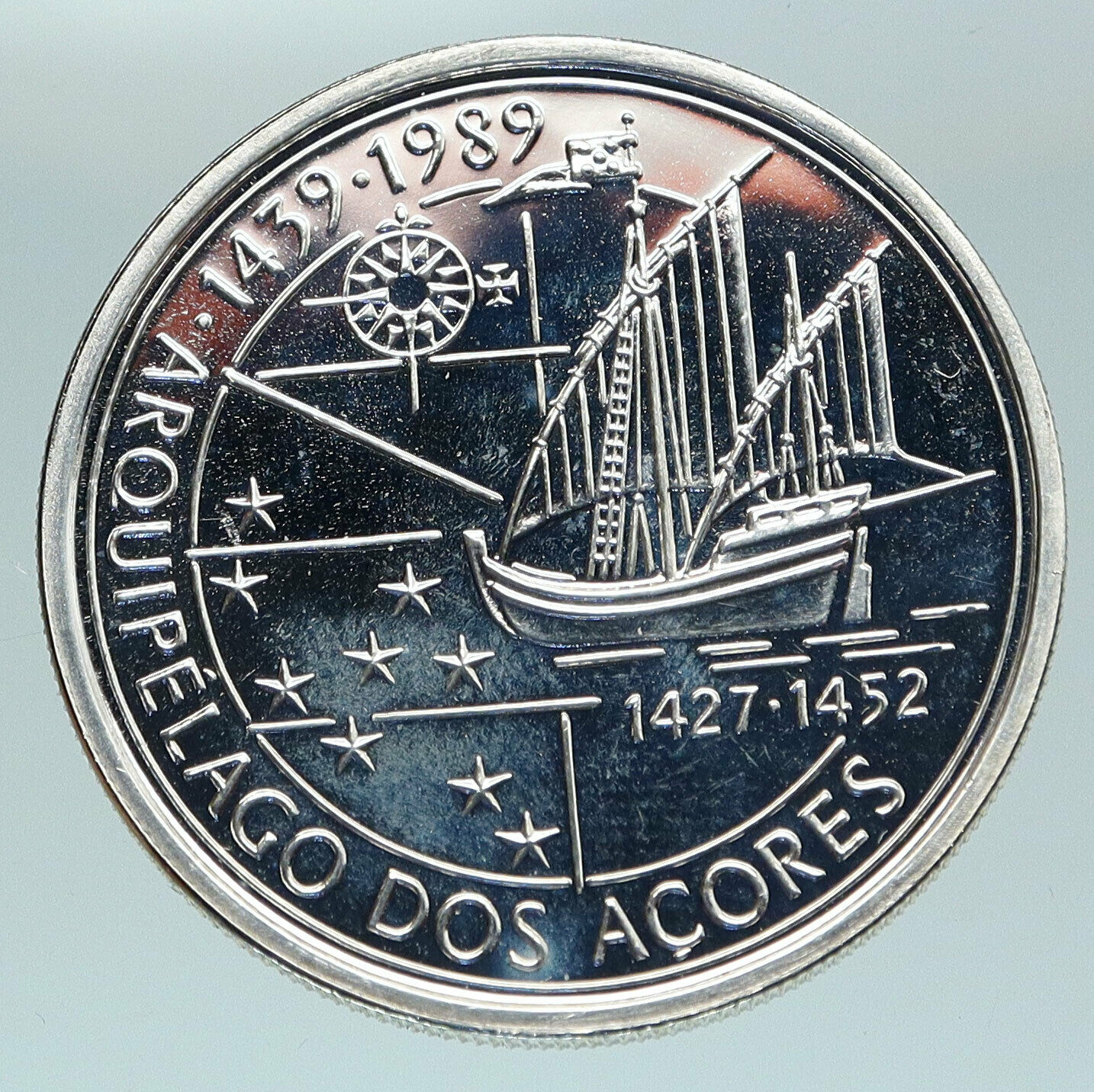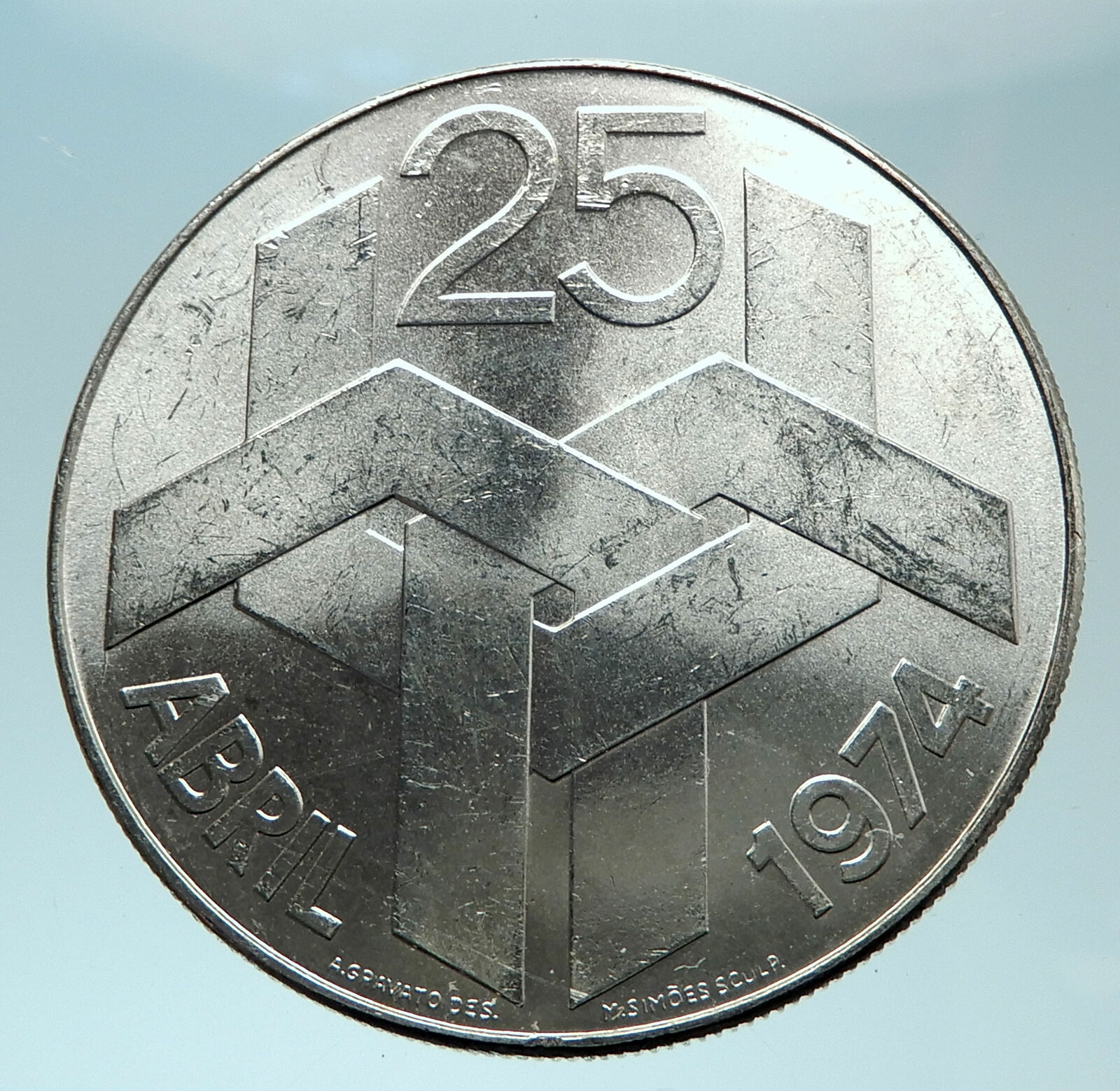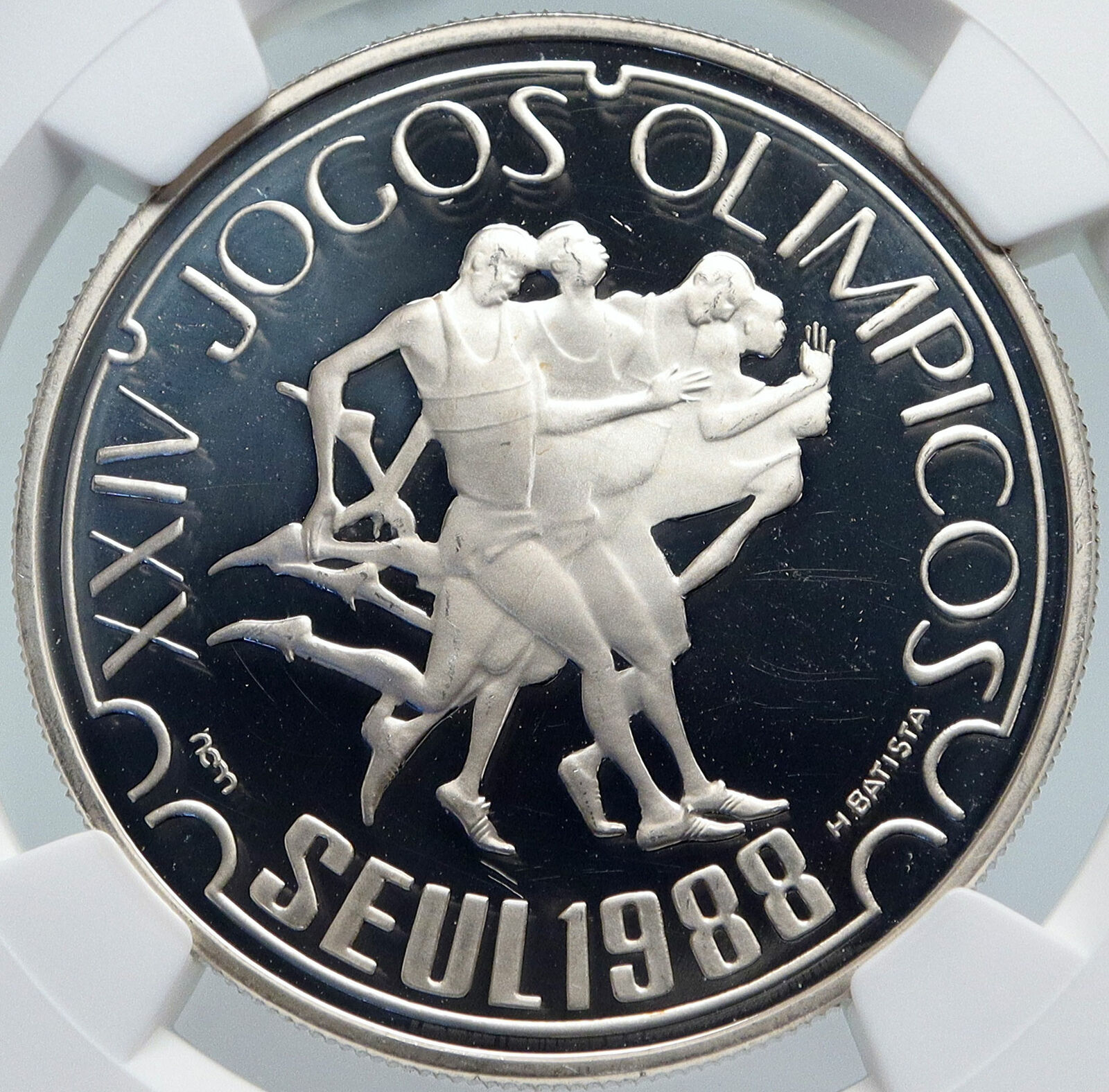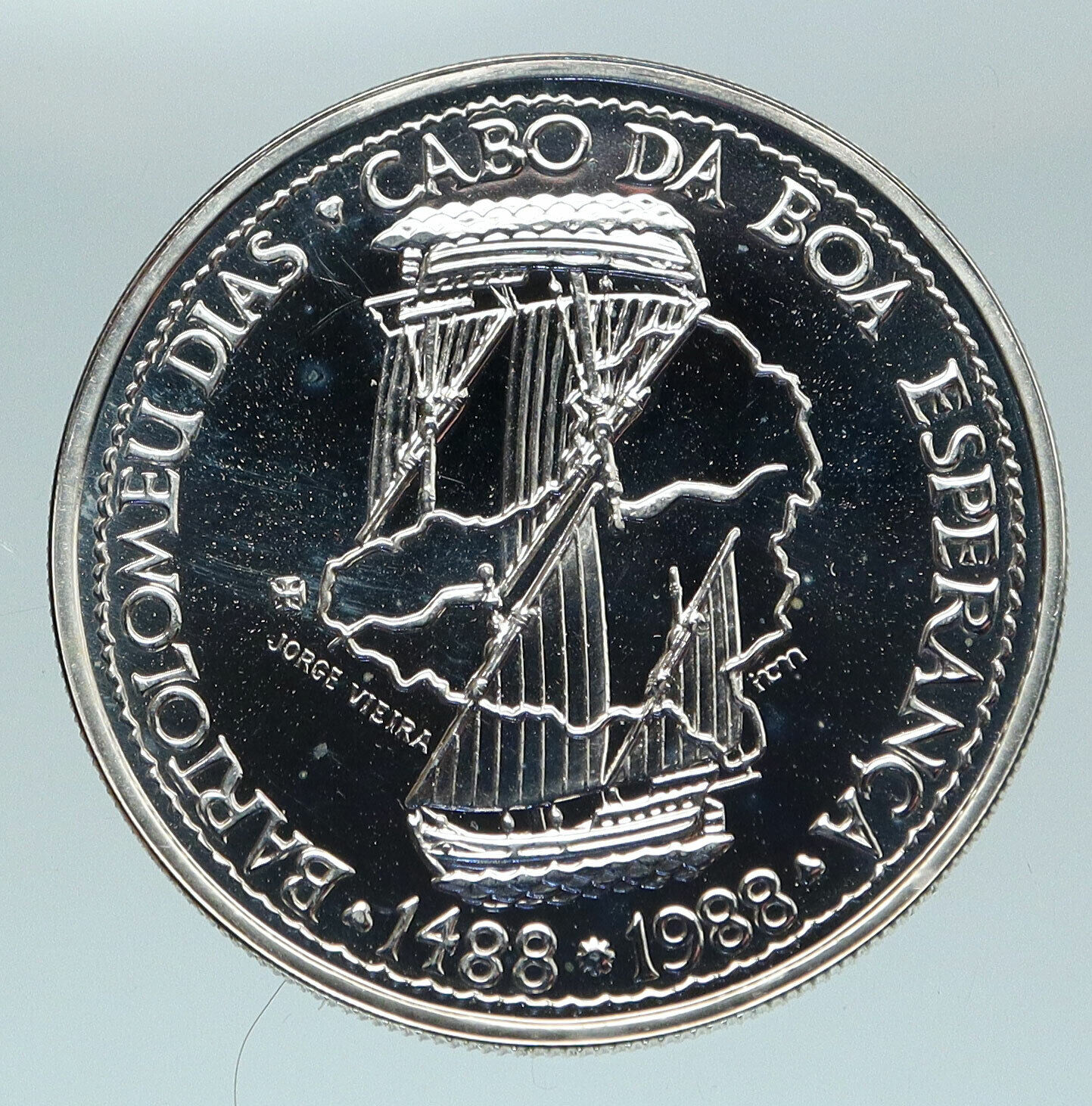|
Portugal
Westward Navigation
1991 Proof Silver 200 Escudos 35mm (26.50 grams) 0.925 Silver (0.7881 oz. ASW)
Reference: KM# 659a
REPUBLICA PORTUGUESA 200 ESCUDOS INCM D’EÇA 1991, Coat-of-Arms of Portugal superimposed to Toscanelli’s map of 1474 inside and hexagon (Europe and Africa to the right, Asie and Japan – Cipangu – to the left, Equatorial line)
NAVEGAÇÕES PARA OCIDENTE 1452 1486, Superimposed on Toscanelli’s map, a stylized boat heading left with 3 sailors onboard holding the rudder, a map, an astrolabe and a sword with the cross of the Order of Christ.
You are bidding on the exact item pictured, provided with a Certificate of Authenticity and Lifetime Guarantee of Authenticity.
 Paolo dal Pozzo Toscanelli (1397 – 10 May 1482) was an Italian mathematician, astronomer, and cosmographer. Paolo dal Pozzo Toscanelli (1397 – 10 May 1482) was an Italian mathematician, astronomer, and cosmographer.
Paolo dal Pozzo Toscanelli was born in Florence, the son of the physician Domenico Toscanelli. There is no precise information on his education and background. Gustavo Uzielli claimed in 1894 that Toscanelli studied at the University of Padua, but modern authors consider this pure conjecture.
Toscanelli is noted for his observations of comets. Among these was the comet of 1456, which was to be named Halley’s Comet after Edmond Halley predicted its return in 1759.
Thanks to his long life, his intelligence and his wide interests, Toscanelli was one of the central figures in the intellectual and cultural history of Renaissance Florence in its early years. His circle of friends included Filippo Brunelleschi, the architect of the Florence Cathedral, and the philosopher Marsilio Ficino. He knew the mathematician, writer and architect Leon Battista Alberti, and his closest friend was Cardinal Nicholas of Cusa—himself a wide-ranging intellect and early humanist, who dedicated two short mathematical works in 1445 to Toscanelli, and made himself and Toscanelli the interlocutors in a 1458 dialogue titled On Squaring the Circle (De quadratura circuli).
Toscanelli along with Nicholas of Cusa appears to have belonged to a network of Florentine and Roman intellectuals who searched for and studied Greek mathematical works, along with Filelfo, George of Trebizond, and the humanist Pope Nicholas V, in company with Alberti and Brunelleschi.
Around 1468 Toscanelli devised the gnomon still to be seen in the Florence Cathedral. A bronze plate let into the dome high above the left transept, and a circular white marble slab let into the floor of the cathedral, which records the summer solstice to a half-second. This was then and subsequently used for centuries for other calculations such as the regular movement of the Sun, effectively a camera obscura.
In 1439, the Greek philosopher Gemistos Plethon, attending the Council of Florence, acquainted Toscanelli with the extensive travels, writings and mapping of the 1st century BC/AD Greek geographer Strabo, hitherto unknown in Italy. Nearly 35 years later, the Italian was to follow up this amplified knowledge.
In 1474, Toscanelli sent a letter and a map to his Portuguese correspondent Fernão Martins, priest at the Lisbon Cathedral, detailing a scheme for sailing westwards to reach the Spice Islands and Asia. Fernão Martins delivered his letter to the King Afonso V of Portugal, in his court of Lisbon. The original of this letter was lost, but its existence is known through Toscanelli himself, who later transcribed it along with the map and sent it to Christopher Columbus, who carried them with him during his first voyage to the New World. Toscanelli had miscalculated Asia as being 5,000 miles longer than it really was, and Columbus miscalculated the circumference of the Earth by 25 percent: both of which resulted in Columbus not realizing initially he had found a new continent.
Toscanelli lived most of his life in Florence, with occasional excursions to Todi and Rome. He is said to have entered into correspondence with scholars around Europe, but his writings have yet to be thoroughly researched.
An uncorroborated story links Toscanelli’s attendance at a Chinese delegation to the Pope in 1432, when many Chinese inventions were discussed, with a flood of drawings made around the same year by the artist-engineer Taccola (1382 – c.1453), which were later developed by Brunelleschi and Leonardo da Vinci. In a 1474 letter by Toscanelli to Columbus, the authenticity of which has been a matter of disagreement among scholars, Toscanelli mentions the visit of men from Cathay (China) during the reign of Pope Eugenius IV (1431–1447):
Also in the time of Eugenius one of them came to Eugenius, who affirmed their great kindness towards Christians, and I had a long conversation with him on many subjects, about the magnitude of their rivers in length and breath, and on the multitude of cities on the banks of rivers. He said that on one river there were near 200 cities with marble bridges great in length and breadth, and everywhere adorned with columns. This country is worth seeking by the Latins, not only because great wealth may be obtained from it, gold and silver, all sorts of gems, and spices, which never reach us; but also on account of its learned men, philosophers, and expert astrologers, and by what skill and art so powerful and magnificent a province is governed, as well as how their wars are conducted.
— Extract of the First Letter of Paolo Toscanelli to Columbus
It has been suggested that the man in question may have been Niccolo da Conti, who was returning from the east and is known to have met with Pope Eugenius in 1444.
In a second letter, Toscanelli describes further these men as extremely learned and willing to share their knowledge:
The said voyage is not only possible, but it is true, and certain to be honourable and to yield incalculable profit, and very great fame among all Christians. But you cannot know this perfectly save through experience and practice, as I have had in the form of the most copious and good and true information from distinguished men of great learning who have come from the said parts, here in the court of Rome, and from others being merchants who have had business for a long time in those parts, men of high authority.
— Extract of the First Letter of Paolo Toscanelli to Columbus
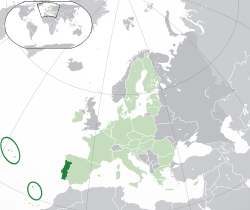  Portugal, officially the Portuguese Republic (Portuguese: República Portuguesa), is a country on the Iberian Peninsula, in Southwestern Europe. It is the westernmost country of mainland Europe, being bordered by the Atlantic Ocean to the west and south and by Spain to the north and east. The Portugal-Spain border is 1,214 km (754 mi) long and considered the longest uninterrupted border within the European Union. The republic also includes the Atlantic archipelagos of the Azores and Madeira, both autonomous regions with their own regional governments. Portugal, officially the Portuguese Republic (Portuguese: República Portuguesa), is a country on the Iberian Peninsula, in Southwestern Europe. It is the westernmost country of mainland Europe, being bordered by the Atlantic Ocean to the west and south and by Spain to the north and east. The Portugal-Spain border is 1,214 km (754 mi) long and considered the longest uninterrupted border within the European Union. The republic also includes the Atlantic archipelagos of the Azores and Madeira, both autonomous regions with their own regional governments.
 The territory of modern Portugal has been continuously settled, invaded and fought over since prehistoric times. The Pre-Celts, Celts, Phoenicians, Carthaginians and the Romans were followed by the invasions of the Visigothic and the Suebi Germanic peoples, who were themselves later invaded by the Moors. These Muslim peoples were eventually expelled during the Christian Reconquista. Portuguese nationality can be traced back to the creation of the First County of Portugal, in 868. In 1139, Afonso Henriques was proclaimed King of Portugal, thus firmly establishing Portuguese independence, under the Portuguese House of Burgundy. The territory of modern Portugal has been continuously settled, invaded and fought over since prehistoric times. The Pre-Celts, Celts, Phoenicians, Carthaginians and the Romans were followed by the invasions of the Visigothic and the Suebi Germanic peoples, who were themselves later invaded by the Moors. These Muslim peoples were eventually expelled during the Christian Reconquista. Portuguese nationality can be traced back to the creation of the First County of Portugal, in 868. In 1139, Afonso Henriques was proclaimed King of Portugal, thus firmly establishing Portuguese independence, under the Portuguese House of Burgundy.
In the 15th and 16th centuries, under the House of Aviz, which took power following the 1383-85 Crisis, Portugal expanded Western influence and established the first global empire, becoming one of the world’s major economic, political and military powers. During this time, Portuguese explorers pioneered maritime exploration in the Age of Discovery, notably under royal patronage of Prince Henry the Navigator and King João II, with such notable discoveries as Vasco da Gama’s sea route to India (1497-98), Pedro Álvares Cabral’s discovery of Brazil (1500), and Bartolomeu Dias’s reaching of the Cape of Good Hope. Portugal monopolized the spice trade during this time, under royal command of the Casa da Índia, and the Portuguese Empire expanded with military campaigns led in Asia, notably under Afonso de Albuquerque, who was known as the “Caesar of the East”.
The destruction of Lisbon in a 1755 earthquake, the country’s occupation during the Napoleonic Wars, the independence of Brazil (1822), and the Liberal Wars (1828-1834), all left Portugal crippled from war and diminished in its world power. After the 1910 revolution deposed the monarchy, the democratic but unstable Portuguese First Republic was established, later being superseded by the “Estado Novo” right-wing authoritarian regime. Democracy was restored after the Portuguese Colonial War and the Carnation Revolution in 1974. Shortly after, independence was granted to all its colonies and East Timor, with the exception of Macau, which was handed over to China in 1999. This marked the end of the longest-lived European colonial empire, leaving a profound cultural and architectural influence across the globe and a legacy of over 250 million Portuguese speakers today.
Portugal is a developed country with a high-income advanced economy and high living standards. It is the 5th most peaceful country in the world, maintaining a unitary semi-presidential republican form of government. It has the 18th highest Social Progress in the world, putting it ahead of other Western European countries like France, Spain and Italy. It is a member of numerous international organizations, including the United Nations, the European Union, the eurozone, OECD, NATO and the Community of Portuguese Language Countries. Portugal is also known for having decriminalized the usage of all common drugs in 2001, the first country in the world to do so. However, the sale and distribution of these drugs is still illegal in Portugal.
|




 Paolo dal Pozzo Toscanelli (1397 – 10 May 1482) was an Italian mathematician, astronomer, and cosmographer.
Paolo dal Pozzo Toscanelli (1397 – 10 May 1482) was an Italian mathematician, astronomer, and cosmographer. 

 Portugal, officially the Portuguese Republic (Portuguese: República Portuguesa), is a country on the Iberian Peninsula, in Southwestern Europe. It is the westernmost country of mainland Europe, being bordered by the Atlantic Ocean to the west and south and by Spain to the north and east. The Portugal-Spain border is 1,214 km (754 mi) long and considered the longest uninterrupted border within the European Union. The republic also includes the Atlantic archipelagos of the Azores and Madeira, both autonomous regions with their own regional governments.
Portugal, officially the Portuguese Republic (Portuguese: República Portuguesa), is a country on the Iberian Peninsula, in Southwestern Europe. It is the westernmost country of mainland Europe, being bordered by the Atlantic Ocean to the west and south and by Spain to the north and east. The Portugal-Spain border is 1,214 km (754 mi) long and considered the longest uninterrupted border within the European Union. The republic also includes the Atlantic archipelagos of the Azores and Madeira, both autonomous regions with their own regional governments. The territory of modern Portugal has been continuously settled, invaded and fought over since prehistoric times. The Pre-Celts, Celts, Phoenicians, Carthaginians and the Romans were followed by the invasions of the Visigothic and the Suebi Germanic peoples, who were themselves later invaded by the Moors. These Muslim peoples were eventually expelled during the Christian Reconquista. Portuguese nationality can be traced back to the creation of the First County of Portugal, in 868. In 1139, Afonso Henriques was proclaimed King of Portugal, thus firmly establishing Portuguese independence, under the Portuguese House of Burgundy.
The territory of modern Portugal has been continuously settled, invaded and fought over since prehistoric times. The Pre-Celts, Celts, Phoenicians, Carthaginians and the Romans were followed by the invasions of the Visigothic and the Suebi Germanic peoples, who were themselves later invaded by the Moors. These Muslim peoples were eventually expelled during the Christian Reconquista. Portuguese nationality can be traced back to the creation of the First County of Portugal, in 868. In 1139, Afonso Henriques was proclaimed King of Portugal, thus firmly establishing Portuguese independence, under the Portuguese House of Burgundy.

